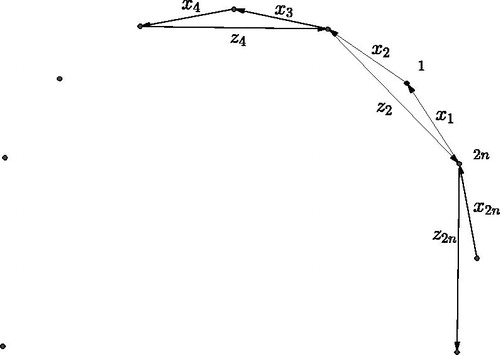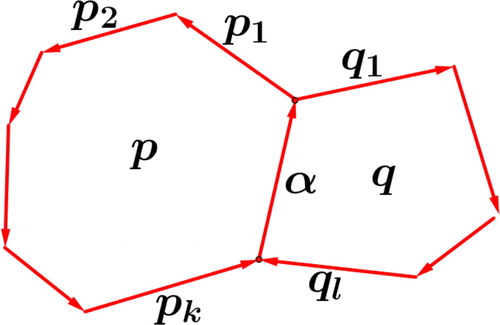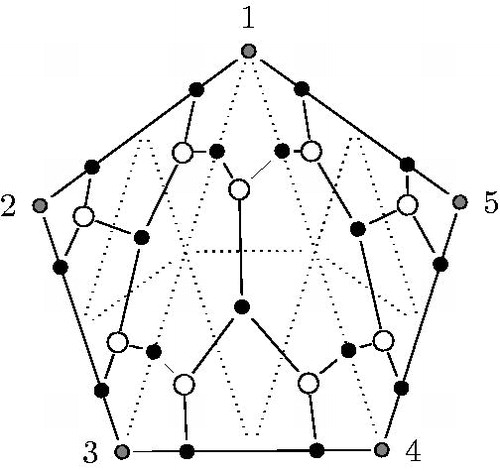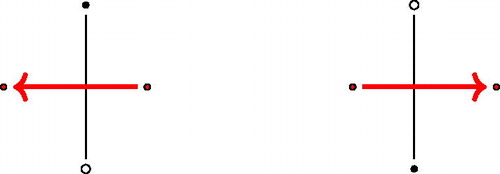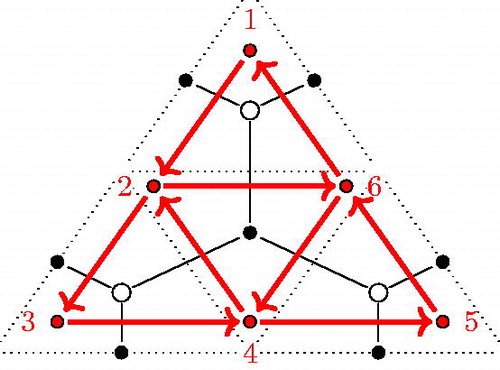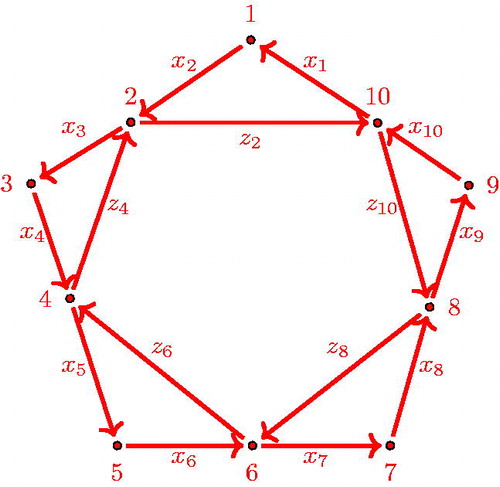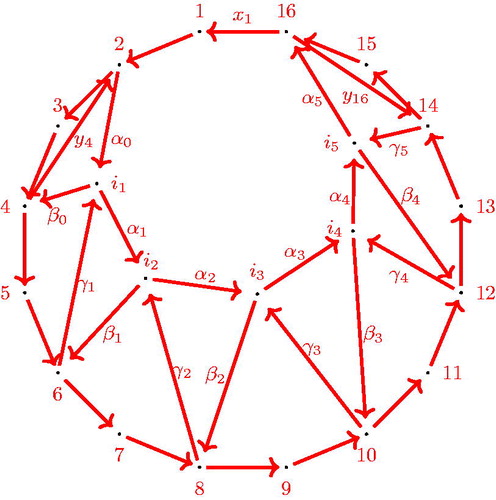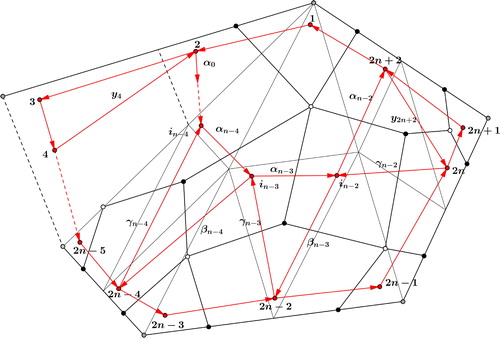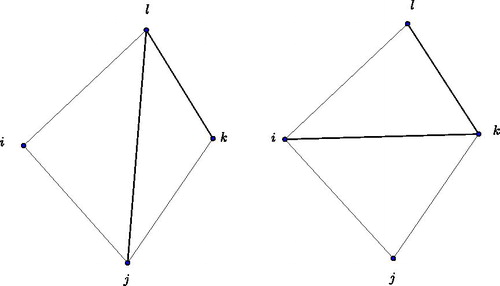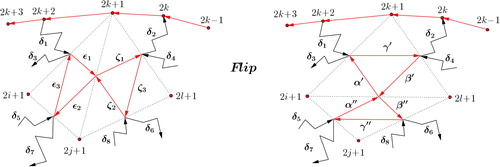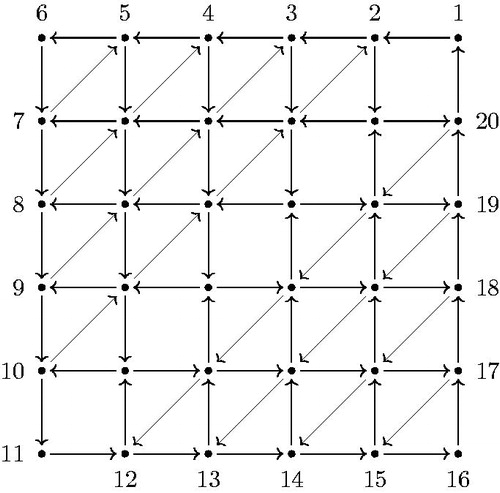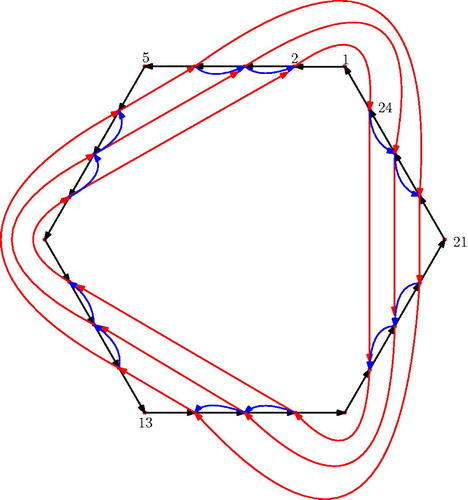 ?Mathematical formulae have been encoded as MathML and are displayed in this HTML version using MathJax in order to improve their display. Uncheck the box to turn MathJax off. This feature requires Javascript. Click on a formula to zoom.
?Mathematical formulae have been encoded as MathML and are displayed in this HTML version using MathJax in order to improve their display. Uncheck the box to turn MathJax off. This feature requires Javascript. Click on a formula to zoom.Abstract
We consider GLm-dimers of triangulations of regular convex n-gons, which give rise to a dimer model with boundary Q and a dimer algebra ΛQ. Let eb be the sum of the idempotents of all the boundary vertices, and the associated boundary algebra. In this article we show that given two different triangulations T1 and T2 of the n-gon, the boundary algebras are isomorphic, i.e.
1. Introduction
Dimer models with boundary were introduced by Baur et al. [Citation1]. In case without boundary the definition is similar to dimer models defined by Bocklandt [Citation2]. Dimer models with boundary are quivers with faces satisfying certain axioms. To any dimer model Q one can associate its dimer algebra AQ as the path algebra of Q modulo the relations arising from an associated potential.
A source for dimer models are Postnikov diagrams of type (k, n) in the disk, introduced by Postnikov [Citation6] and used in [Citation1] as a combinatorial approach to Grassmannian cluster categories. In general, dimer algebras arising from different (k, n) diagrams are not isomorphic. However, if you consider their boundary algebra, which is the idempotent subalgebra where
is the sum of all idempotents corresponding to the boundary vertices, then one of the main results of [Citation1] is that for any two (k, n)-diagrams the associated boundary algebras are isomorphic.
In this article, we study another source for dimer models, the so-called GLm-dimers. They arise from Goncharov’s -webs on disks defined in [Citation3]. In the case when S is a disk with n special points on the boundary,
-webs describe a cluster coordinate systems on the moduli space
as shown in [Citation3]. This moduli space is defined as n-tuples of the moduli space
of all decorated flags in an m + 1-dimensional vector space
where U is the upper triangular unipotent subgroup in
modulo the diagonal action of the group
where Ωm is a volume form in Vm.
The purpose of this article is to show that on the disk the boundary algebra of any two different GLm-dimers are all isomorphic.
The paper is structured as follows. After giving the necessary background in Section 2, we will first prove this result for the boundary algebra of a GL2-dimer in Section 3 and address the general case in Section 4.
For GL2-dimers, the main result is the following: the quiver of the boundary algebra of any GL2-dimer on an n-gon is given by the following quiver shown in .
Any two 3-cycles incident with a common vertex is equivalent. Furthermore, any composition is equivalent to the corresponding composition of
arrows
reducing modulo 2n and considering the composition of paths from left to right.
The strategy to prove this result is to first prove it for boundary algebras arising from fan triangulations and then to show flip invariance.
Throughout this paper, when we consider indices modulo k, we always assume them to be between 1 and k. In particular, 0 is never used as an index.
2. Settings and the GLm-dimer
2.1. Background
Definition 2.1
(quiver with faces). A quiver with faces is a quiver together with a set Q2 of faces and a map
which assigns to each
its boundary
where Qcyc is the set of oriented cycles in Q (up to cyclic equivalence).
We will always denote a quiver with faces by Q, regarded now as the tuple A quiver with faces is called finite if Q0,Q1 and Q2 are finite sets. The (unoriented) incidence graph of Q, at a vertex
has vertices given by the arrows incident with i. The edges between two arrows α,β correspond to the paths of the form
 occurring in a cycle bounding a face.
occurring in a cycle bounding a face.
Definition 2.2
(dimer model with boundary [Citation1]). A (finite, oriented) dimer model with boundary is given by a finite quiver with faces where Q2 is written as disjoint union
satisfying the following properties:
the quiver Q has no loops, i.e. no 1-cycles, but 2-cycles are allowed,
all arrows in Q1 have face multiplicity 1 (boundary arrows) or 2 (internal arrows),
each internal arrow lies in a cycle bounding a face in
and in a cycle bounding a face in
the incidence graph of Q at each vertex is connected.
Note that, by (b), each incidence graph in (d) must be either a line (at a boundary vertex) or an unoriented cycle (at an internal vertex).
2.2. The dimer algebra and the boundary algebra
Definition 2.3
(natural potential W). Let be a dimer model with boundary. Then the following formula
defines the natural potential associated to Q.
Remark
(differentiation of W). Let be the set of all cyclic derivatives with respect to all internal arrows α in Q. That means, if α is both part of the negative (clockwise) cycle
and the positive (counterclockwise) cycle
with
as shown in , then the equation
holds. In this article we use the notation
for relations obtained by the natural potential W.
Definition 2.4
(dimer algebra). Let be a dimer model with boundary and let W and
be defined as above. Then the dimer algebra ΛQ is defined as
As usual, we write e to denote an idempotent of an algebra and in the path algebra let ei be the trivial path of length zero at vertex i. It is an idempotent of
Define
where
are the boundary vertices of the quiver; i.e. the vertices that are incident with boundary arrows. Furthermore, we call the remaining vertices of the quiver internal (or inner) vertices and all arrows, that are incident with at least one internal vertex are called internal (or inner) arrows.
Definition 2.5
(boundary algebra). The boundary algebra of a dimer model Q with boundary is the spherical subalgebra consisting of linear combinations of paths which have starting and terminating points on the boundary of the quiver (i.e. one of the idempotent elements ):
2.3. The GLm-dimer
Definition 2.6
(triangulation). A triangulation of a regular convex polygon is a subdivision of the n-gon by diagonals into triangles, where each pair of diagonals intersects at most in one of the vertices of the polygon.
Remark.
Every triangulation of an n-gon uses n – 3 diagonals.
Remark.
A special case of triangulation is the so called fan triangulation, where each diagonal of the triangulation contains a given fixed vertex of the polygon.
We recall Goncharov’s definition of bipartite graphs of an m-triangulation of a decorated surface S as in [Citation3]. We use these graphsFootnote1 to define a family of dimer models with boundary.
Definition and construction 2.7
(GLm-dimer). Take an arbitrary triangulation of the polygon. Every triangle is subdivided with -lines in equidistance parallel to each of its sides, as in (left) for m = 4. Each triangle of the triangulation is now subdivided into small triangles of two kinds, namely upwards and downwards triangles w.r.t. an arbitrary edge. The subdivided triangle in the case of m = 4 consists of 10 upwards and 6 downwards triangles for example.
From such a subdivision we create a bipartite graph: We apply the following procedure to each triangle of the triangulation (see (right)).
Put black points on the midpoints of the short segments of the sides of the original triangle (e.g. either diagonals of the triangulation or edges of the polygon) and put black points into every downwards triangle.
Put a white point inside every upwards triangle.
Finally two points are connected if they differ in color and the points belong to the same small triangle or their small triangles have a side in common.
We call the resulting graph a GLm-dimer.
According to the first point of this list, there are exactly m black points on each of the diagonals of the triangulation and on the edges of the initial polygon. shows a GL2-dimer of a triangulated pentagon.
The resulting graph is bipartite and its complement splits the original surface into several connected components.
2.4. The boundary algebra of a GLm-dimer
We can associate a dimer model with boundary to a GLm-dimer:
Put a vertex in each connected component of the complement of the GLm-dimer.
Then connect adjacent components by arrows such that the white point of the dimer is on the left hand side of the arrow, shown in . Since the GLm-dimer is bipartite, the quiver arising from it is a dimer model with boundary; each white vertex sits in a counterclockwise face and each black vertex in a clockwise face. Note that and
are the set of all faces whose boundaries are oriented counterclockwise and clockwise respectively.
The quiver Q of the GLm-dimer of a triangle fulfills all aspects of Definition 2.2 and hence it is a dimer model with boundary.Footnote2 An example of the quiver of the GL2-dimer of a triangle is shown in . The boundary vertices of the quiver are denoted by 1, 6.
Definition 2.8
(chordless cycle). A chordless cycle of a quiver Q is a cycle such that the full subquiver on its vertices is also a cycle.
Remark 2.9.
The following fact is due to the definition of a dimer model with boundary:
Let Q be the dimer model of a GLm-dimer and ΛQ the corresponding dimer algebra. Let k be an arbitrary vertex of ΛQ with at least two incoming and two outgoing arrows. Then, up to c1 = c2 for any two chordless cycles c1, c2 starting at k.
Examples of quivers of GLm-dimers are shown in for m = 2 and in for m = 5. In our particular setting, the number of faces (cycles) incident with a vertex i is always 1 or 3 for boundary vertices and 4 or 6 for internal vertices.
By Remark 2.9, all chordless cycles at a given vertex are equal and hence it makes sense to refer to any one of them as the cycle at this vertex.
Definition 2.10
(short cycle u). Let i be a vertex of Q, then we write ui for a chordless cycle at i.
3. The boundary algebras of dimer models of GL2-dimers of arbitrary triangulations of the n-gon are isomorphic
Recall that is the boundary algebra obtained from the quiver Q of a GL2-dimer of a triangulation of an n-gon, where
denotes the sum of all boundary idempotents.
We also recall the quiver from the introduction. For n = 5, it has the form shown in .
Theorem 3.1
(Main Theorem). The quiver of with relations
is isomorphic to
subject to the following relations (writing compositions of paths from left to right), for
, where indices are considered modulo 2n:
Furthermore the element
is central in
The proof of Theorem 3.1 is split into two main steps. First, we consider fan triangulations and show by induction, that in this case the boundary algebra has the desired structure for any n. The second step is to show that the flip of a diagonal does not change the boundary algebra i.e.
is flip-invariant. Using the fact that every triangulation of a polygon can be reached from any starting triangulation under application of finitely many flips (Theorem (a) in [Citation4]), we get the claimed result.
3.1. The boundary algebra of a fan triangulation
The goal of this chapter is to show that the boundary algebra of a fan triangulation is isomorphic to the algebra Before describing the boundary algebra, the structure of the quiver of a fan triangulation of an n-gon will be determined. We will write
for the dimer model of the GL2-dimer of a fan triangulation of the n-gon.
Proposition 3.2.
Let be the dimer model with boundary of a fan triangulation of the n-gon,
. Then
has the following form:
It consists of 2n vertices on the boundary, labeled anticlockwise by , and n – 3 internal vertices labeled
Furthermore it has arrows between the boundary vertices, with
and indices taken modulo 2n,
and arrows
Remark.
The quiver has
faces.
The quiver is illustrated in .
Proof.
The claim follows inductively by removing 2-cycles of the dimer model using the relations obtained by the natural potential W. Note that on the dimer, this reduction corresponds to replacing every subgraph of the form shown on left hand side in to the form shown on the right hand side. The case n = 3 is the induction basis. The quiver of has the claimed form, see .
Assume that has the described form for
and consider the GL2-dimer of the fan triangulation of the
-gon. It can be obtained from the fan triangulation of the n-gon by adding a triangle to it at vertex 1 to the end of the fan. The dimer is obtained analogously. Observe that the same reduction steps can be done for the GL2-dimer of the
-gon as for the one of the n-gon, because the only difference between the two triangulations is the additional triangle between 1, n and
which does not change the GL2-dimer of the former n-gon. The reduction steps are the one described in . shows the relevant part of the reduced dimer, i.e. the new part obtained by increasing the number of vertices of the polygon. Note that it is possible to reduce the new dimer as the regions I and II indicate. This leads to the reduced dimer shown in , containing the reduced quiver
The new quiver has 2 additional faces, the chordless cycles 2n,
and 2n,
So it has the claimed structure.□
Figure 10. A fan triangulation of the -gon and new part of the dimer. The labeling corresponds to the vertices of the
-gon.
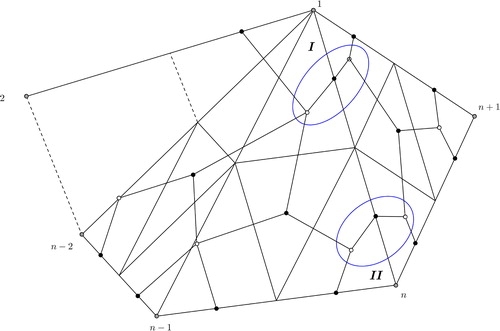
Remark.
Whenever we have a 2-cycle of internal arrows in the quiver of a GLm-dimer, we can remove it using the relations from the potential. From now on we will always tacitly remove such 2-cycles from our dimer model and will use the phrases GLm-dimer and quiver instead of” reduced GLm-dimer” and” reduced quiver”.
Knowing the structure of the quiver of a fan triangulation in detail, it is now possible to describe the boundary algebra of the n-gon.
Definition 3.3.
We define paths as follows:
(1)
(1)
(2)
(2)
(3)
(3)
(4)
(4)
Lemma 3.4.
The xi, together with the
as defined in Definition 3.3 generate the boundary algebra of
Remark.
The set is minimal in the sense that any proper subset does not suffice.
Proof.
For the convenience of the reader, shows in order to make it easier to follow the argumentation by using relations obtained by the natural potential W for different internal arrows.
We show that each path from 2 to 2n factors through z2. Assume to the contrary that a path δ from 2 to n does not factor through z2. We can assume that δ does not contain cycles. Then the following two cases can occur: Either or there exists a k,
such that αk is not an arrow of δ, w.l.o.g let k be minimal, i.e.
In the first case we get the equivalence of the following paths:
(5)
(5)
The last equality holds as the path is a chordless cycle at 2n. Hence δ factors through z2 in the first case. In the second case, as δ does not contain cycles,
must be of the form
for some path
Then
which is a contradiction to the minimality of k. Hence every path from 2 to 2n factors through z2. The rest of the statement follows with similar arguments.□
Now we want to prove that the relations between the arrows stated in the previous section are fulfilled for the boundary algebra of the fan triangulation of a polygon. Let be the dimer algebra of
and let
Note that we will always reduce indices modulo 2n.
Proposition 3.5.
The boundary algebra satisfies the following relations for
:
Proof.
By the same calculations as in (5) of Lemma 3.4 we immediately get the equality of the paths
All other relations of type (I.) follow from Lemma 3.4 in the same way. The second kind of relation has already been stated in Remark 2.9, as both sides of the equation are short cycles at boundary vertex 2k.□
Thus we described the boundary algebra of the GL2-dimer of a fan triangulation for arbitrary large n in detail and it remains to show flip invariance in order to get the main result for m = 2.
3.2. Flips in the boundary algebras
This section starts with the definition of a diagonal flip of a triangulation in order to show that a flip does not change the structure of the boundary algebra itself. As already shown the boundary algebra of the fan triangulation has the structure given in Theorem 3.1. Together with the main result of this section (Theorem 3.9), this proves that all boundary algebras arising from GL2-dimers of arbitrary triangulations of an n-gon are isomorphic.
Definition 3.6
(Diagonal flip of a triangulation.). For a triangulation a diagonal flip is defined as follows. Let (l, j) be a diagonal of the triangulation of the n-gon. Then two triangles l,j,k and l,j,i belong to the triangulation. A flip, as shown in , is the removal of the diagonal (l, j) replacing it by the diagonal (i, k).
Note that a diagonal flip is always a local operation that only changes the structure around vertices corresponding to the edges of the quadrilateral, and hence a local operation on the GL2-dimer and the corresponding dimer algebra. Furthermore, every triangulation of a polygon can be reached from any starting triangulation by application of finitely many flips, see Theorem (a) in [Citation4]. Recall that denotes the quiver of the GL2-dimer of a fan triangulation of an n-gon with dimer algebra
and eb the sum of the boundary idempotents of
Lemma 3.7.
Let and μ be the flip of the diagonal
of
. Let
be the sum of the boundary idempotents of
. Then there is an isomorphism
Proof.
By Lemma 3.4 the xi, together with the
generate the boundary algebra
and these elements fulfill relations (I.) and (II.) by Proposition 3.5.
We consider the flip μ of the diagonal of the n-gon and the new dimer algebra
the relevant part is shown in . Here the paths δ1 and δ2 are
and hence might be empty. Furthermore, if j = 3, then
and if
then
and
We know that every path of from 2 to 2n factors through
The boundary algebra
has generators in terms of Lemma 3.4, which we now want to describe in detail. First notice that
for
are also generators in
because a diagonal flip does not change the boundary.
Claim: Every path from 2 to 2n in factors through
with
(6)
(6)
Proof of the Claim. We can assume w.l.o.g. that does not contain a cycle (otherwise, by removing the cycle, every path from 2 to 2n would still factor through it). Furthermore, because the flip does not change the rest of the arrows (apart from the internal arrows
and
), every path from 2 to 2n still factors through δ1 and δ2 in
The generator for paths from 2 to 2n must contain at least one arrow of the new quadrilateral, because otherwise this generator would already have existed in the original dimer algebra, a contradiction to the fact that all paths from 2 to 2n factor through
in
The arrows or
immediately lead to a cycle at
or
respectively, so they can’t be part of the generator
As
is not part of
if
is part of the generator, it has to be the only arrow of the new quadrilateral.
Assume now that is not part of
Then at least one of the arrows
or
has to be part of the generator
If was part of it, then either
or
were also part of the generator. The former is a contradiction as mentioned above, the latter to
using an arrow of the new quadrilateral, as
The other cases lead to contradictions similarly.
Analogously, we can define
Furthermore, as every path, which does not contain arrows of the new quadrilateral remains unchanged, we can define for all
Then the set
generates
in a minimal way as in Remark after Lemma 3.4.
It remains to show, that the relations are fulfilled in Of course, the relations
hold in
by Remark 2.9.
We have to check the relations
for all paths involving arrows of the new quadrilateral. Let i = j, then
This last path does not contain an arrow of the new quadrilateral, hence we can apply Proposition 3.5 and get the desired result:
All further relations involving arrows of the quadrilateral follow analogously.
A direct consequence of the proof of Lemma 3.7 is:
Corollary 3.8.
The isomorphism of Lemma 3.7 is induced by
(7)
(7)
(8)
(8)
Theorem 3.9.
Let Q be the quiver of the GL2-dimer of an arbitrary triangulation of the n-gon, with dimer algebra ΛQ and the sum of the boundary idempotents of ΛQ. Then there is an isomorphism
Proof.
We prove the claim by induction over the number of flips.
The induction basis is Lemma 3.7.
For the induction step, we use that we can reach any triangulation of an n-gon by a finite number of diagonal flips. So let Q be the quiver of an arbitrary triangulation and
where
are t flips of diagonals (writing flips from right to left).
By the induction hypothesis, we know that
The induction step follows in a similar way as in the proof of Lemma 3.7. Note that illustrates the effect of an arbitrary flip, the paths from and to the quadrilateral involved may differ from those in Lemma 3.7 in general. However, the arguments for checking do not change. Hence we get the desired result,
□
Corollary 3.10.
Consider the boundary algebra of a dimer model Q of a GL2-dimer of an arbitrary triangulation of the n-gon. Then the element t,
is a central element of this algebra.
Proof.
The element t is the sum of exactly one chordless cycle for every boundary vertex and hence commutes with every element of □
4. The general case
In this section, we describe the boundary algebras for arbitrary m.
Starting with the GLm-dimer as defined in Section 2, we can reduce the dimer and achieve the quiver of an n-gon equivalently as for m = 2 for arbitrary m. From now on, we will assume that the dimer (and hence the quiver) is always reduced.
shows the quiver of the GL5-dimer of a triangulation of the quadrilateral. This example already shows, that there is a new type of generators arising for describing the boundary algebra: Let’s have an informal look at boundary vertex 10. In contrast to the case where m = 2, there are not only paths to 11 and 9 but also an additional path to 2 which cannot be reduced by any of the relations. Hence we need a third type of generators. In order to introduce a formal notation for the generators, we have a closer look at the internal vertices. We can give a formula for the number of internal vertices, depending on m and n.
Definition 4.1
(polygonal numbers of second order). For a polygon with s vertices, the kth s-gonal number of second order is
Remark.
Using the setting as in definition above, the polygonal number (of first order) is defined as see A057145 in the OEIS [Citation5].
Proposition 4.2.
The number of internal vertices of the dimer model of the GLm-dimer of the fan triangulation of the n-gon is for n > 3.
Proof.
The proof is done by induction on n and m. First let m be fixed. For induction basis let n = 4. The number of internal vertices equals by construction, which coincides with
Let the number of internal vertices
of the GLm-dimer of the fan triangulation of the n-gon be
Consider the n + 1-gon, where we add a triangle to the fan. By construction of the GLm-dimer, we get
additional vertices by adding a triangle. By using the induction hypothesis,
and we achieve the desired result.
Now let n be fixed. For m = 2, the number of inner vertices of the GL2-dimer of an n-gon is and coincides with
Again, let the number
of internal vertices of the GLm dimer of the n-gon be
If we increase m by one, the number of internal vertices increases by
by construction of the GLm-dimer. So the number
of internal vertices of quiver of the GL
-dimer is by using induction hypothesis
and the proof is done.□
Remark.
The number of internal vertices is the same for any triangulation of the n-gon.
Before we can state the structure of the quiver of the GLm-dimer of the fan triangulation of the n-gon, we have to introduce some notation.
The boundary vertices are labeled by anticlockwise.
The quiver contains m – 1 disjoint nested oriented paths from
to nm – i for
formed by successive arrows. We will denote them by αP, where P is the sink of the arrow. The internal vertices are labeled by a 3-tuple (a, b, c) depending on their position along these oriented paths as follows:
denotes the triangle, to which the internal vertex can be assigned to.
is one less than the starting vertex of the nested path.
counts the number of internal vertices up to b in every triangle.
shows the labeling of all internal vertices of The arrows are all indexed by their sinks. Along the boundary they are
All the other arrows are as follows:
Figure 16. Quiver of the GL4-dimer of the fan triangulation of a hexagon. For illustration, some arrows are labeled.

Notation 4.3.
In the definition of the different types of arrows is shown in the case of the GL4-dimer of a hexagon: Beside the black boundary arrows xk the remaining arrows can be identified as follows: The bold black arrows are named αi, the blue arrows βi and the green arrows γi, where the index i always coincides with the labeling of the sink of the arrow. This means i is either a triple (a, b, c) or some natural number in
with
Note that additionally to the arrows and vertices of the quiver the diagonals of the original triangulation are drawn as dotted lines to emphasize the idea of labeling the internal vertices (a, b, c).
Proposition 4.4.
Let be the quiver of the fan triangulation of the n-gon,
. Then
has the following form:
It consists of vertices on the boundary, labeled anticlockwise by
, and
internal vertices labeled (a, b, c), with a,b and c as described above.
Furthermore it has arrows between the boundary vertices
and the internal arrows as described in 4.3.
Proof.
The proof is similar to the proof of 3.2.
Equivalently to former section, we define some elements of the boundary algebra and show, that these elements are generating the algebra.
Definition 4.5.
We define paths and
as follows:
(9)
(9)
(10)
(10)
(11)
(11)
(12)
(12)
(13)
(13)
(14)
(14)
(15)
(15)
Remark.
The products above might be empty, which happens in equations when k = m. In these cases, only a single arrow remains. These are exactly the arrows
Note that the notation of the arrows zi is different to the previous section, because of the new type of generators.
We will now define a quiver and show, that the boundary algebra of is isomorphic to it up to some relations.
Definition 4.6.
The quiver is defined by
vertices labeled anticlockwise and
arrows
shows the quiver
Remark.
The indices of the tail l and head with
of yk fulfill
which is equivalent to the description of yk in Definition 4.6.
As in the previous section we first describe the boundary algebra of the dimer algebra where
is the quiver of the GLm-dimer of the fan triangulation of the n-gon.
Proposition 4.7
(Boundary algebra of the fan triangulation). The boundary algebra is isomorphic to
satisfying the following relations obtained by the natural potential W:
where
and indices always considered modulo
Proof.
The proof is done by combining Remark 2.9, Lemma 3.4 and Proposition 3.5 applied to the general case.
The flip-invariance in case of m > 2 is a direct consequence of Theorem 3.9.
Theorem 4.8
(Flip equivalence). Let be the quiver of the GLm-dimer of the fan triangulation of the n-gon, let
be the quiver of the GLm-dimer of an arbitrary triangulation of the n-gon, with
and
the corresponding dimer algebras and eb respectively
the sum of the boundary idempotents for
and for
respectively. Then there is an isomorphism
Proof.
Combine the structure of the fan triangulation shown in Proposition 4.7 with the proof of Theorem 3.9 for the general case.□
Corollary 4.9.
Consider the boundary algebra of a dimer model Q of a GLm-dimer of an arbitrary triangulation of the n-gon. Then the element t,
is a central element of this algebra.
Proof.
The element t is the sum of exactly one chordless cycle for every boundary vertex and hence commutes with every element of □
Hence, as a consequence of Proposition 4.7 and Theorem 4.8, we can state the main result for the general case:
Theorem 4.10
(Main Theorem). Let be the boundary algebra obtained from the dimer model Q of a GLm-dimer of an arbitrary triangulation of the n-gon. Then the quiver of
with relations
is isomorphic to
subject to the following relations, for
and indices are considered modulo
:
Furthermore the element
is central in
Proof.
Proposition 4.7, Lemma 3.7 and Theorem 4.8, together with Corollary 4.9 give the desired result.
Acknowledgements
The author wishes to thank his supervisor Karin Baur for her great advice and support and an anonymous referee for carefully reading the manuscript and providing many helpful suggestions.
Additional information
Funding
Notes
1 Up to a changed condition at the boundary.
2 We will often use the notation quiver instead of dimer model with boundary for readability of the article.
References
- Baur, K., Marsh, R., King, A. (2016). Dimer models and cluster categories of Grassmannians. Proc. London Math. Soc. 113(2):213–260. DOI: 10.1112/plms/pdw029.
- Bocklandt, R. (2012). Consistency conditions for dimer models. Glasgow Math. J. 54(2):429–447. DOI: 10.1017/S0017089512000080.
- Goncharov, A. B. (2017). Ideal Webs, Moduli Spaces of Local Systems, and 3d Calabi-Yau Categories, Algebra, Geometry, and Physics in the 21st Century, Progr. Math., 324, Cham: Birkhäuser/Springer, 31–97.
- Hatcher, A. (1991). On triangulations of surfaces. Topol. Appl. 40(2):189–194.
- Sloane, N. J. A. editor, The on-line encyclopedia of integer sequences. Available at: https://oeis.org, 23.1.2020
- Postnikov, A. Total positivity, Grassmannians, and networks, arXiv:math/0609764v1 [math.CO] Sep 2006.

